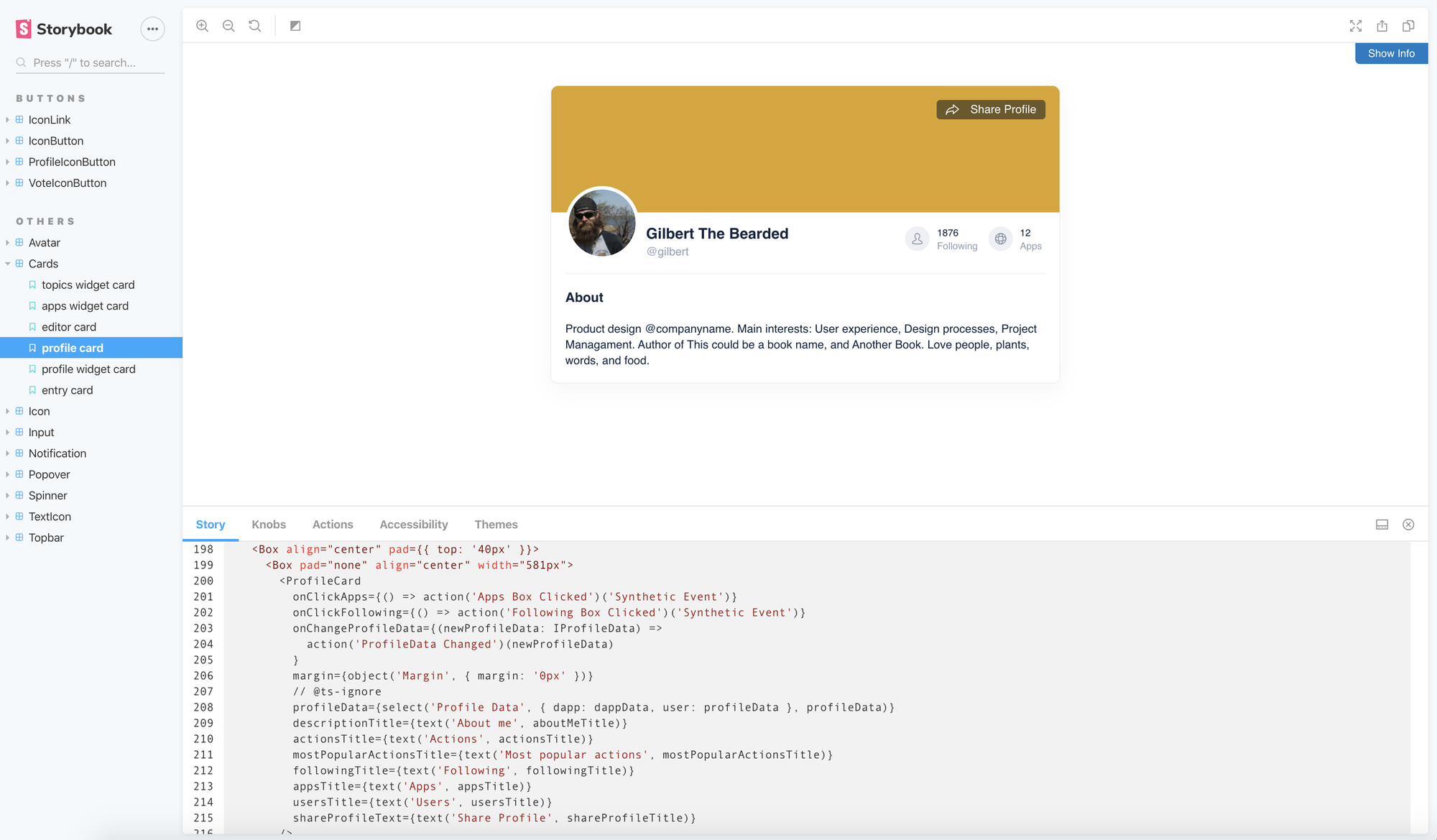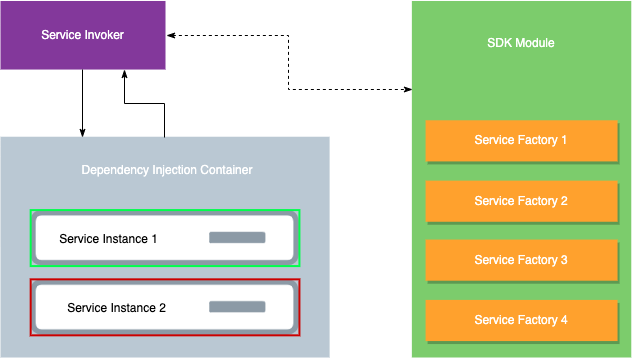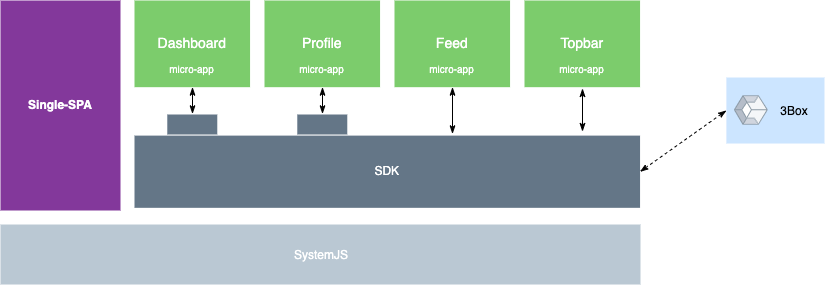AWF - A Dev Team Overview

This year (2019) on World Press Freedom Day, we announced the AKASHA World Framework (AWF) - a tool for the creation and cultivation of bespoke networks - through the post AKASHA Reloaded: Three Spins Around The Sun Later.
The main purpose of the AWF is to facilitate the development of what we're calling worlds, so in our vision it should deliver:
- a set of UI elements to be reused across all the worlds and apps;
- a library for API, caching and data persistency; and
- an application-loader system.
In order to check the first requirement, the UI elements, we started with an idea that AWF will be used in-house, but also by other developers to build their own web3 apps; in order to allow that to happen we embraced the philosophy of atomic design.
How does this translate into our technical choices?
For building a scalable and modern UI there are so many options nowadays it can feel overwhelming, but we wanted to make sure the choices we make now are based on sound principles, and will be easy to maintain in the future.
What we are using to build our UI
The stack that is the foundation of our UI is composed of react.js, grommet, styled components, and storybook.js. Our team was already experienced with react, and it has a huge ecosystem around it, so this was an easy choice.
To make sure our UI components are as encapsulated and easy to use as possible we decided to go for styled components, and this led us to adopt a component library that is based on styled components.
Grommet is a library that we fell in love with, well documented and easy to extend and adapt to our needs. This time we learned from our mistakes and decided to use typescript on the front end as well. Considering our big hopes for the growth of this project, typescript provides the consistency needed to properly scale our framework.
And finally, we decided to use storybook to showcase our components, making it easier for outside developers to check out the functionality of our components, and making collaboration between the dev team and design team much easier.
To follow the guidelines of atomic design we started by implementing the small components first, such as buttons, basic cards, and modals and then composed them into progressively more complex components that can be plugged directly into the layout of a micro-app.

Another interesting choice on the frontend side was on what library to use for our rich text editor. We wanted something open-source, lightweight and that won't get in our way when we develop custom features for publishing. After a few tries we went with slate.js, a well-documented, react-based, and very flexible editor framework.
What we are using to build the API library (SDK)
Initially when we started to work following the AKASHA Reloaded initiative, we tried to find an application architecture that would solve the extensibility and isolation problem that we had for the beta version of AKASHA because the majority of the work was being put into fixing regression bugs.
In an ideal scenario, each module of the application would have these features:
- doesn't have in its dependencies list other modules;
- can access API methods from other modules without having to import the entire library;
- can run isolated tests without too much boilerplate;
- can be swapped easily without breaking the entire application; and
- low overhead, is loaded only when needed.
Having this list in mind we came up with a solution which uses the dependency injection pattern, basically it's a container where you can register modules and their exported methods as services.
For example, lets say that we have a service that looks like:
const service = () => { const fullName = (firstName, lastName) => `${firstName} ${lastName}`; return { fullName } } // And it registers with: export default { service, name: "Utils" } // This is a service factory
This service can be used from other modules/services:
``` const otherService = (invoke) => { const fullNameAndAge = (first, last) => { const { fullName } = invoke("Utils"); return fullName(first, last) + "42"; } return { fullNameAndAge } }
export default { service: otherService, name: "UtilsExtra" } ```
This small example checks the first 3 items from the list of desired behavior:
- the
UtilsExtramodule doesn't import explicit theUtilsmodule; - it can access the
fullNamemethod through the invoker; and - it can run isolated tests without too much boilerplate, it would require just a mock of the invoked method:
``` const invoker = function(moduleName) { return { fullName: () => {} } }
// when registering the service we can pass the invoker const registeredService = service(invoker);
// add isolated tests starting from here : ```

What we are using for the application management
When we started to draft the first specs of Ethereum World, we came up with an architecture that allowed as to develop different parts of the app independently from each other (kind of a "plugin" system). After a few iterations on this concept we ended up with an architecture called "micro-frontends" on which we started to develop a system that will allow instantiation of different parts of the application (micro-apps).
Even though the idea of micro-frontend is simple, we wanted to avoid isolating ourselves behind some "not-so-popular" concepts and APIs like Custom Elements, and leverage the "popular" frontend libraries (React, Angular, Vue, etc) instead.
So, after a little research, we have discovered an interesting library called Single-SPA which we concluded would fit our needs. Two of the main features that we inherit by using Single-SPA and that we were interested in:
- Modularization. Historically we spent a lot of time doing maintenance work over a monolithic web application (especially upgrading dependencies, state management, and redesign were getting harder as the application became bigger). We've learned a lot from our previous application (AKASHA Web dapp) and we wanted to avoid a monolithic app.
- Framework agnostic. What if, in the future, we want to switch from one library/framework to another? Going with a monolithic app this would be almost impossible. Rewriting the whole app from scratch wouldn't be an option. Single-SPA would allow us to gradually migrate from one library to another. It would even let us develop micro-apps using different technologies (let's say React, Vue, Svelte) and use them in the same page.
Then we have started to build a micro-application loader on top of this library which will allow us to instantiate/render a micro-app on specific pages (routes), leading us to the current architecture:

How does it work?
The entire concept is based around a "world." A world is basically an application that features a set of preinstalled micro-apps that are specific to a community. For example, Ethereum World will have profiles and article feed micro-apps preinstalled. Users are free to install any other app that is available, locally, in their browser.
This means that any developer can write a micro-app and then distribute it inside any world.
How will the design system fit into a micro-app? Just import from our design library the component you need into the micro-app, pass it the required props and you're good to go! It's easy to extend the styles of each component to suit the specific need of the layout by leveraging styled components, and they come with theme-able props, allowing the developer to easily customise the look of their micro-app.
In order to work, a micro-app needs to implement a simple API that will let our SDK application loader register it on demand. The AKASHA SDK is a collection of modules and services that can be used to create an AKASHAworld. It contains also the lookup/verify logic for packages (plugins) and it also handles things like external API access, caching, data persistency, and client-side routing; on top of this all the registered service callbacks are transformed into observables.
For example, at the moment of writing the API looks like this:
// app-register.js { // this micro-app will load when the route is // www.example.com/search activeWhen: { path: '/search', }, // UI loading logic - currently managed by single-spa-react loadingFn: () => import('./components'), name: 'my-search-app', // app's internal name sdkModules: ["Search"], // sdk modules initialization (more on this later) title: 'My Search App', // Page title }
Note: the API may change by the time we make it open-source
``` // components.js import {SearchField, DropDown} from '@akasha/design-system';
const MySearchPage = () => { handleSearch = (searchStr) => { // get some search results sdk.search.findName('John') } return (
... show search results ) } ```
``` // sdk/search.service.js
const service = () => { const findName = (startsWith) => "John Doe"; return { findName } } export default { service, name: "Search" } ```
Now, whenever you visit Ethereum World/search, this micro-app will be loaded and executed giving you a search functionality.
If this post has inspired you; if you are into self-sovereign technologies to advance human agency; if you are driven to work with cryptonetworks for societal good; if the concept of a collective mind blows your own; or if a combination of any of the above resonates with you check out our job listings.
You could be just the puzzle piece we're looking for...
